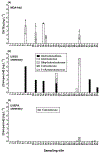Occurrence and In Vitro Bioactivity of Estrogen, Androgen, and Glucocorticoid Compounds in a Nationwide Screen of United States Stream Waters
- PMID: 28401766
- PMCID: PMC11247474
- DOI: 10.1021/acs.est.6b06515
Occurrence and In Vitro Bioactivity of Estrogen, Androgen, and Glucocorticoid Compounds in a Nationwide Screen of United States Stream Waters
Abstract
In vitro bioassays are sensitive, effect-based tools used to quantitatively screen for chemicals with nuclear receptor activity in environmental samples. We measured in vitro estrogen (ER), androgen (AR), and glucocorticoid receptor (GR) activity, along with a broad suite of chemical analytes, in streamwater from 35 well-characterized sites (3 reference and 32 impacted) across 24 states and Puerto Rico. ER agonism was the most frequently detected with nearly all sites (34/35) displaying activity (range, 0.054-116 ng E2Eq L-1). There was a strong linear relationship (r2 = 0.917) between in vitro ER activity and concentrations of steroidal estrogens after correcting for the in vitro potency of each compound. AR agonism was detected in 5/35 samples (range, 1.6-4.8 ng DHTEq L-1) but concentrations of androgenic compounds were largely unable to account for the in vitro activity. Similarly, GR agonism was detected in 9/35 samples (range, 6.0-43 ng DexEq L-1); however, none of the recognized GR-active compounds on the target-chemical analyte list were detected. The utility of in vitro assays in water quality monitoring was evident from both the quantitative agreement between ER activity and estrogen concentrations, as well as the detection of AR and GR activity for which there were limited or no corresponding target-chemical detections to explain the bioactivity. Incorporation of in vitro bioassays as complements to chemical analyses in standard water quality monitoring efforts would allow for more complete assessment of the chemical mixtures present in many surface waters.
Figures




Similar articles
-
De Facto Water Reuse: Bioassay suite approach delivers depth and breadth in endocrine active compound detection.Sci Total Environ. 2020 Jan 10;699:134297. doi: 10.1016/j.scitotenv.2019.134297. Epub 2019 Sep 4. Sci Total Environ. 2020. PMID: 31683213 Free PMC article.
-
In vitro effects-based method and water quality screening model for use in pre- and post-distribution treated waters.Sci Total Environ. 2021 May 10;768:144750. doi: 10.1016/j.scitotenv.2020.144750. Epub 2021 Jan 23. Sci Total Environ. 2021. PMID: 33736315 Free PMC article.
-
Estrogenic, androgenic, and glucocorticoid activities and major causative compounds in river waters from three Asian countries.Environ Sci Pollut Res Int. 2023 Feb;30(8):20765-20774. doi: 10.1007/s11356-022-23674-6. Epub 2022 Oct 18. Environ Sci Pollut Res Int. 2023. PMID: 36255587
-
Analysis of the sensitivity of in vitro bioassays for androgenic, progestagenic, glucocorticoid, thyroid and estrogenic activity: Suitability for drinking and environmental waters.Environ Int. 2017 Feb;99:120-130. doi: 10.1016/j.envint.2016.12.014. Epub 2016 Dec 22. Environ Int. 2017. PMID: 28017361 Review.
-
What level of estrogenic activity determined by in vitro assays in municipal waste waters can be considered as safe?Environ Int. 2014 Mar;64:98-109. doi: 10.1016/j.envint.2013.12.009. Epub 2013 Dec 31. Environ Int. 2014. PMID: 24384232 Review.
Cited by
-
Stress, Sex, and Sugar: Glucocorticoids and Sex-Steroid Crosstalk in the Sex-Specific Misprogramming of Metabolism.J Endocr Soc. 2020 Jul 3;4(8):bvaa087. doi: 10.1210/jendso/bvaa087. eCollection 2020 Aug 1. J Endocr Soc. 2020. PMID: 32734132 Free PMC article. Review.
-
Public and private tapwater: Comparative analysis of contaminant exposure and potential risk, Cape Cod, Massachusetts, USA.Environ Int. 2021 Jul;152:106487. doi: 10.1016/j.envint.2021.106487. Epub 2021 Mar 19. Environ Int. 2021. PMID: 33752165 Free PMC article.
-
Water, Water Everywhere, but Every Drop Unique: Challenges in the Science to Understand the Role of Contaminants of Emerging Concern in the Management of Drinking Water Supplies.Geohealth. 2023 Dec 28;7(12):e2022GH000716. doi: 10.1029/2022GH000716. eCollection 2023 Dec. Geohealth. 2023. PMID: 38155731 Free PMC article. Review.
-
Exposures and potential health implications of contaminant mixtures in linked source water, finished drinking water, and tapwater from public-supply drinking water systems in Minneapolis/St. Paul area, USA.Environ Sci (Camb). 2023 Jul 1;9(7):1813-1828. doi: 10.1039/d3ew00066d. Epub 2023 May 11. Environ Sci (Camb). 2023. PMID: 40546683 Free PMC article.
-
Expanded Target-Chemical Analysis Reveals Extensive Mixed-Organic-Contaminant Exposure in U.S. Streams.Environ Sci Technol. 2017 May 2;51(9):4792-4802. doi: 10.1021/acs.est.7b00012. Epub 2017 Apr 12. Environ Sci Technol. 2017. PMID: 28401767 Free PMC article.
References
-
- Kolpin DW; Furlong ET; Meyer MT; Thurman EM; Zaugg SD; Barber LB; Buxton HT, Pharmaceuticals, hormones, and other organic wastewater contaminants in U.S. streams 1999-2000: A national reconnaissance. Environ. Sci. Technol 2002, 36, 1202–1211. - PubMed
-
- USEPA, Aquatic life criteria for contaminants of emerging concern. White paper; 2008.
-
- Benotti MJ; Trenholm RA; Vanderford BJ; Holaday JC; Stanford BD; Snyder SA, Pharmaceuticals and endocrine disrupting compounds in U.S. drinking water. Environ. Sci. Technol 2009, 43, 597–603. - PubMed
-
- WHO/UNEP, State of the science of endocrine disrupting compounds. Bergman A, Heindel JJ, Jobling S, Kidd KA, Zoeller RT (eds.) 2012.
MeSH terms
Substances
Grants and funding
LinkOut - more resources
Full Text Sources
Other Literature Sources
Medical
Research Materials

